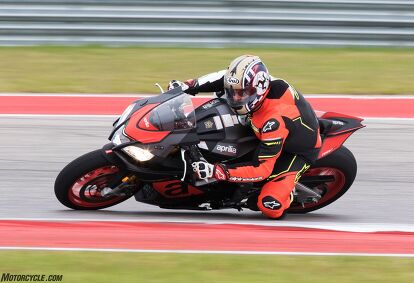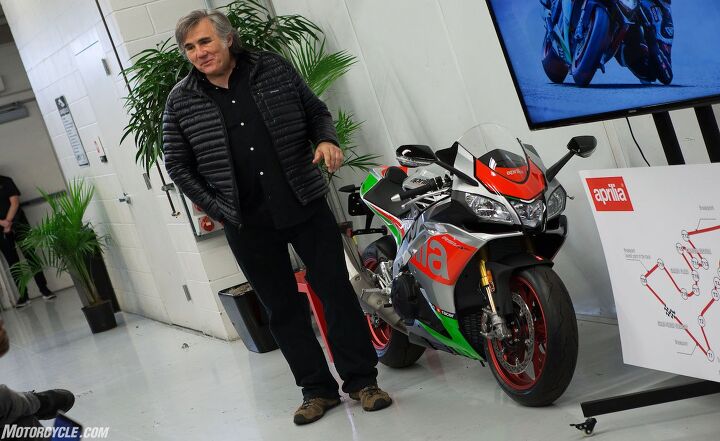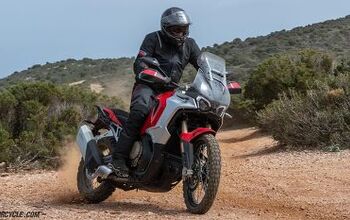2017 Aprilia RSV4 RR/RF Review – First Ride
Batting competitors away by virtue of electronics
After a half-decade of sitting second chair to BMW’s S1000RR ( Honorable Mention 2010, and again in 2015) Aprilia’s RSV4 finally, deservedly, secured Motorcycle.com’s 2016 Sportbike of the year award. Subjectively, the RSV and its V-Four engine have been a staff favorite every year since its introduction, but where does one go after having ascended the throne? For the 2017 RSV4 RR and RF, the answer is improved electronics.
Last year brought a variety of much needed mechanical upgrades to the RSV resulting in a 16-horsepower bump to a claimed 201 hp at the crank ( measured rear wheel output of 179.5 at 13,700 rpm), effectively equalling BMW’s claimed 199 hp ( measured rear wheel output 182.9 at 13,100 rpm). Although we didn’t conduct a multi-superbike shootout last year, there was a cage match between the RSV4 RR and Kawasaki’s then new-to-the-scene ZX-10R ( The $17,000 Superbike Faceoff) in which the RSV emerged the winner. Also like last year, the RSV returns looking much the way it has since its inception because, to paraphrase Piaggio’s chief designer Miguel Galluzzi, when you create a bike that looks this good, there’s no reason to change every year.
Getting back to this year’s models, we detailed in full all the upgrades to both the RF and RR back in October in our 2017 Aprilia RSV4 And Tuono V4 1100 Previews. In a nutshell, here’s what happened:
- New ATC: Aprilia Traction Control, adjustable on the fly, with 9 settings including off, now has even more fine-tuned and higher-performance operating logic.
- New AWC: Aprilia Wheelie Control, adjustable to 3 levels, includes more precise operating strategies thanks to the repositioning of the inertial platform. Wheelie control can now be adjusted on the fly without closing the throttle, like the ATC, thanks to the new switchgear.
- New ALC: Aprilia Launch Control, for use on the track only, with 3 settings, uses even more effective operating strategies.
- New AQS: Aprilia Quick Shift, the electronic strategy that allows shifting without closing the throttle and without using the clutch, now allowing clutchless downshifting.
- New APL: Aprilia Pit Limiter, the system that lets you select and limit the top speed allowed in pit lane at the track or simply to make it easier to comply with posted speed limits on the road.
- New ACC: Aprilia Cruise Control.
- New APL: Cornering ABS, a Bosch 9.1 MP multi-map Cornering ABS (C-ABS) system optimizing cornering stability via constant monitoring of lateral acceleration, lean angle, pitch, and yaw angle, and, of course, the amount of pressure being applied at the front brake lever. Adjustable to 3 levels and can be switched off.
- New RLM: Rear Lift-up Mitigation, a system that limits the lift of the rear wheel during heavy braking.
- New Color TFT Digital Instrumentation.
- New V4-MP: Multimedia Platform, smartphone connectivity for corner-by-corner calibration of electronics setting (TC, ABS, C-ABS, etc.), as well the infotainment system including voice commands.
How’s that for a boatload of acronyms? More importantly, how do they affect the performance of our reigning champ?
After spending the weekend studying the lines of various MotoAmerica and MotoGP riders cutting inhumanly fast laps around the COTA circuit, then having to wait a day while Troy rode the new 2017 Suzuki GSX-R1000, it was finally my turn to take to the track. Having never ridden COTA, learning its 3.4-mile 20-turn layout was somewhat daunting, but I can’t think of another bike I’d rather be aboard for the learning curve.
2017 Aprilia RSV4 RR
First up, the RR. Outfitted for 2017 with an up-and-down quickshifter and Brembo M50 calipers gripping larger 330mm discs, the RR, at $16,999, arguably represents the best of what is possible in this price range. Extolling dominant engine performance and a chassis we’ve praised with every flattering analogy we can think of, the RR had me quickly up to speed around COTA.
2017 Aprilia RSV4 RR
| Engine | 20.0/20 |
| Suspension/Handling | 13.5/15 |
| Transmission/Clutch | 9.75/10 |
| Brakes | 10/10 |
| Instruments/Controls | 4.5/5 |
| Ergonomics/Comfort | 9.0/10 |
| Appearance/Quality | 9.5/10 |
| Desirability | 9.25/10 |
| Value | 9.0/10 |
| Overall Score | 94.5/100 |
Accelerating off the slow Turn 11, pointing the RSV down COTA’s long back straight and firing, the 65-degree V-Four spins furiously fast, reaching speeds in excess of 170 mph before brake pressure need be applied. Learning just how fast and how deep into the corner the RSV can be pushed before slowing for the tight Turn 12 took multiple tries as the RSV sheds speed rapidly, and it takes some experimenting before you’re brave enough to keep the throttle pinned with brake markers approaching at what seems lightspeed.
Keeping all this ferociousness manageable is Aprilia’s laudable electronics package. For the most part, I kept both ATC and AWC at level 1, allowing for an enjoyable amount of rear-wheel spin and enough front-wheel lift to make me feel like a MotoGP stud in full control of a 200-horsepower firebreather (see image below). The best part is you know there are electronic aids working in the background, but they’re never intrusive enough for you to know they’re functioning other than the occasional dashboard light illuminating – unless, of course, you have ATC turned way up.
We started the day with the ride mode set to Track, then by our third session and no crashes, Aprilia felt confident with us switching to Race mode, which allows the engine to spin quicker in the first few degrees of throttle twist. I actually preferred Track mode, as Race mode changes power delivery from rheostat to lightswitch, making throttle modulation a more difficult task, especially through COTA’s S sections where small throttle adjustments are required. I switched back to Track mode – without having to pit because Aprilia makes most adjustments on-the-fly easy – and left it there for the remainder of sessions.
2017 Aprilia RSV4 RF
Switching to the RF model, it was apparent on the first lap out what top-shelf suspension and lightweight forged wheels bring to the table. Hosting its first race a short five years ago, all those cars lapping COTA since have rippled the pavement in various places throughout the circuit. The RSV4 RF, outfitted with the latest gen Öhlins NIX fork and TTX shock, was better able to manage all the dips and bumps around the COTA circuit. Not to say the RR’s Sach’s fork and monoshock don’t perform admirably, but when ridden back-to-back, it’s hard to overlook the increased compliancy. In hindsight, without having a direct comparison, I’d be totally happy with the performance of the Sachs units and would welcome the reduced MSRP they reflect.
2017 Aprilia RSV4 RF
| Engine | 20.0/20 |
| Suspension/Handling | 14.75/15 |
| Transmission/Clutch | 10/10 |
| Brakes | 9.75/10 |
| Instruments/Controls | 4.5/5 |
| Ergonomics/Comfort | 9.0/10 |
| Appearance/Quality | 9.5/10 |
| Desirability | 9.75/10 |
| Value | 8.5/10 |
| Overall Score | 95.75/100 |
More significant (to me, at least) are the forged wheels the RF wears. The first time through COTA’s S turns on the RF, the difference felt as though the RR model was outfitted with wheels of concrete as the RF transitioned with a renewed sense of ease and immediacy. The reduced rotating mass coupled with the Öhlins ability to deal with surface imperfections exposed an increased sense of stability, generating more confidence in my ability to attack the COTA circuit.
Shifting either model around the COTA course is made ridiculously easy by way of Aprilia’s up-and-down quickshifter. The system worked flawlessly, eagerly grabbing gears without hesitation, and downshifting, blipping the throttle as it goes, all the way to first gear without upsetting the chassis. The only way to interrupt the operation is by allowing your foot to rest atop the shifter, which stops the system from grabbing the next gear. We’ve found that sometimes what works at track speeds and aggression levels doesn’t always transfer to street use, so we’ll have to wait until we have an RSV in our possession as to how its quickshifter works in the real world of street riding.
When you piece the whole picture together; a manageable 200-hp engine, grade-A suspension and brake components, MotoGP-level electronics, and magic-carpet-ride handling, you begin realizing the RSV4 RF would probably run circles around a 10-year-old World Superbike racer. All for a $23k MSRP.
If that price is a little steep – which it certainly is for a lot of us – the RR model is a perfectly good substitution, offering the best aspects of the RF model in a much more affordable package at $16,999. In fact, purchasing the RR model and installing a set of forged aluminum wheels will get you seriously close to the RF while still keeping the price below $20k. Either way, the RSV4 remains one of the best liter-class superbikes a performance junkie can wish to own. How it measures up against the competition will soon be discovered in our upcoming 2017 Superbike Shootout.
2017 Aprilia RSV4 RR
+ Highs
- Brembo M50 Calipers
- Up-and-down Quickshifter
- TFT Display
– Sighs
- Finicky “Select” function on new 4-way toggle
- Heavier than the new CBR1000RR and GSX-R1000
- I don’t know, I love this bike
2017 Aprilia RSV4 RF
+ Highs
- Forged Wheels
- Öhlins NIX fork and TTX shock
- V4-MP Multimedia Platform
– Sighs
- Engine braking adjustment is not independent from ride mode selection
- Price Tag
- And I love this bike even more
A former Motorcycle.com staffer who has gone on to greener pastures, Tom Roderick still can't get the motorcycle bug out of his system. And honestly, we still miss having him around. Tom is now a regular freelance writer and tester for Motorcycle.com when his schedule allows, and his experience, riding ability, writing talent, and quick wit are still a joy to have – even if we don't get to experience it as much as we used to.
More by Tom Roderick


















































Comments
Join the conversation
Interesting to note how big an improvement just the forged wheels seem to make. Incredibly expensive option when offered on other bikes. But maybe worth it.
If I were anywhere talented enough to ride a race replica correctly it would be the Ape.